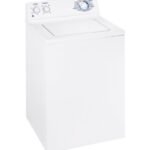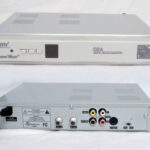About seven years ago I drove to my nearest Best Buy store in search of a basic (read “cheap!”) two-channel stereo receiver for occasional nightly use in a bedroom. At that time, for more serious use in my home’s primary music-listening area, I still owned a high-end Luxman R117 receiver for which I’d paid about $850 back in 1988 (a “steal” for that model at the time!). [The latter Luxman unit–in terms of overall specs–was a contender for the title of “best mass-market stereo receiver ever manufactured.” Conventional stereo receivers (as opposed to “audiophile” amps sans built-in tuners and collectively termed “separates”) virtually never rivaled the Luxman R117’s high-caliber specs for low harmonic distortion, etc.]
Actually, all I’d wanted out of the “bedroom” receiver was something via which to connect a Sony dual-well cassette deck to play certain obscure audio books (not available in formats other than audio cassette) at bedtime. I had scarcely any interest in using any of the receiver’s other capabilities, including its digital tuner (radio). Hence, I was on the prowl for a basically bottom-end model, but one that still included the convenience of remote control, not to mention an outwardly appealing, conventional configuration that would harmonize with my black Sony “ES” tape deck.
Arriving at Best Buy, I discovered that their own cheapest “house-brand” product was a $79 KLH R3000 stereo receiver packing 200 watts of power (100 watts per channel) and a remote control handset. Initially, I found the outward appearance of this unit’s LED display a bit underwhelming contrasted with the multifaceted, multicolored counterparts on costlier receivers. Nevertheless, this Chinese-made product was affordable and did, at least, fit my aforementioned usage criteria, and so I hastily bought it, took it home, and set it up.
The first thing that I discovered was that–using the supplied, rudimentary (wire/loop) antennas–neither FM nor AM radio reception (from the area of my house where that bedroom is located) was sufficiently good enough to bother using. Contrasted with my aforementioned Luxman receiver’s tuner, this one seemed pathetically weak. If I’d been seriously interested in using its tuner (which I wasn’t and never have been), I would’ve either immediately returned this cheapo to Best Buy, or I might have added a superior, third-party (possibly electrically amplified) antenna.
On the other hand, everything else about this KLH R3000 receiver worked quite satisfactorily. Mind, I only had it connected to a pair of modest “Baby Advent” speakers. Nonetheless, I was pleased with how my audiobooks sounded, not only via the loudspeakers but also via the receiver’s headphone jack.
About a year later, I reluctantly decided to sell my aging Luxman R117 receiver (whose remote had stopped functioning) at eBay. perceived performance was, at least, quite tolerable for the majority of recordings I played. Admittedly, dynamic range and sound stage weren’t fully as impressive or well defined; nevertheless, the overall listening experience was, well, “close enough” for my increasingly tolerant, middle-aged ears. 😉
“Who woulda thunk” that $79 could buy so much in the way of performance, not to mention convenience and style?
That was when I belatedly began viewing this low-end product with at least a modicum of respect. Let me summarize some of its noteworthy features.
The console:
The outer, black-painted-steel enclosure is thick and durable enough to withstand typical use. It’s well ventilated on the top and sides. I’ve never detected any excessive heat buildup. Nonetheless, I suggest that you never place other components directly atop a high-wattage amp (or receiver), including this one.
Rear panel: The uncluttered rear panel of this somewhat limited receiver has: stereo (left/right) “RCA” jacks for attaching (up to) four audio components of various kinds (e.g., CD or tape players); speaker terminals for connecting a pair of loudspeakers; and FM/AM antenna terminals.
Front panel: A rather large LED window occupies the upper center portion of the main (front) panel. The frequency number, preset number, and either an “AM” or “FM” symbol are concurrently visible and basically horizontally arranged/viewable within the display.
In other (non-radio) modes, the LED display will generally comprise merely one discreet symbol (e.g., “CD”).
There is also a (normally not displayed) “SPEAKERS OFF” indicator. Unlike some receivers at various levels of the price spectrum, this modest KLH unit’s LED panel is not garishly multicolored but (virtually) discreetly monochromatic.
To the left of the central LED display window are six buttons controlling power, speakers, and tuning functions. For the “power” and “speakers” functions, you simply repeatedly press a given button to activate or deactivate the given function.
When you press the POWER button to activate the system, the unit defaults to the last operational mode (e.g., “CD”) it was in before power was removed.
The SPEAKERS button allows you to switch the loudspeakers on or off. If you switch off the speakers (e.g., when you want to connect a pair of headphones), a “speakers off” indicator fairly conspicuously illuminates within the LED display.
You can either “manually” or “automatically” search for radio stations. You can preset up to (a total of) 30 of your favorite AM and FM radio stations.
At the lower left of the front panel, a PHONES jack allows you to use a set of stereo headphones; there is no separate, dedicated volume knob for that jack.
Directly below the central LED display window are a dozen rather stylishly, vertically shaped buttons arranged horizontally across the face of the unit. These control: the radio-station presets and other tuner functions; and the remaining buttons are for selecting any of the four audio-input modes (for playing CD’s, tapes, etc.).
To the right of the central LED display window is one large and three small rotary knobs.
The most conspicuous rotary knob is the motorized main volume control. Directly beneath the main volume knob are the relatively tiny (and self-explanatory) “balance,” “bass,” and “treble” knobs.
The remote:
The KLH remote control unit–with its rather prosaic keypad layout of smallish keys–is compact enough to comfortably fit the average hand. Basically (excepting the “balance,” “bass” and “treble” functions), virtually all functions on the receiver’s front panel are replicated on the remote.
I’ve had no difficulty operating this remote from a distance up to about 20 feet; farther away than that, precise pointing and fresh batteries are critical. After years of continual use, all the keys remain intact and responsive, although I rather doubt that the most frequently used (e.g., “volume”) keys will remain fully responsive for the duration of the receiver’s life.
Closing thoughts:
Several years ago, when I showed an acquaintance (not an audiophile but a lover of fine furniture) an online image of this low-end, all-black receiver’s front panel, he remarked that it evinced admirably restrained taste on the part of the “KLH” designers; instead of oversized, conspicuous buttons and knobs, these were unobtrusively sculpted and arranged. And the LED display (except when in “AM/FM” mode) displayed merely the word “CD,” etc., corresponding to the currently activated audio-input mode. Rather than a garishly motley display of reds, yellows or greens, there was merely a soft, monochromatic LED glow in the very center of the ample window. [It didn’t seem right for me to inform that astute acquaintance that said “KLH” designers had likely been at least as interested in economy as in style. Besides, when reconsidering the latter notion, I concluded that said designers’ greatest triumph had been in achieving sensible yet tasteful styling on a modest budget!]
By the law of averages, my KLH R3000 stereo receiver has not only already outlasted numerous specimens from the same production run but also some infinitely costlier amps from the most reputable manufacturers. Shoot, even my best-of-its-ilk Japanese Luxman R117 had required $150 of service (some capacitors needed replacing)–and a superfluous green LED had expired–during its first five years of comparable use. By contrast, this “Chinese cheapo” remains fully functional in all respects. At this rate, I won’t be unduly shocked if it either survives another decade or expires tomorrow–such are the unpredictable vagaries of electronic components. I do know that, in the event of trouble, it would be pointless to try to repair what is clearly a prime example of a “disposable” mass-market product.
About a year after I’d connected this receiver to my high-end B & W 801’s, I “eBayed” the latter behemoths for nearly $3,000. Given that I’d originally paid around $3,900 for them in the summer of 1990, I figured I’d gotten my money’s worth (not to mention years of “audiophilic” pleasure) out of them, and there was no telling how many more years they’d last anyway. Besides, my “backup” speakers weren’t exactly chopped liver: a pair of pristine B & W DM2000’s costing well over a grand when I’d found them being liquidated as showroom demos in the summer of 1988. Though the latter speakers can’t match the 801’s house-shaking bass or uncannily accurate “mids” and highs, they ironically are a bit easier on the ear (because they’re less “revealing”) whenever I’m playing pop-music CDs. On the other hand, when I’m playing “demonstration-quality” classical recordings, well, I do somewhat miss my 801’s!
In any case, this KLH receiver works as acceptably driving my B & W DM2000’s as it did with the power-hungry 801s. This cheapo continues to give me no compelling reason to replace it with a “quality” receiver or “separates.” If only every bottom-end amp or receiver could boast its combination of style, simplicity, convenience and longevity, electronics enthusiasts might think twice about shelling out for high-end amplification and instead allocate their money toward what arguably matters most: transparently accurate speakers (and, where applicable, some quality stands for the latter).






